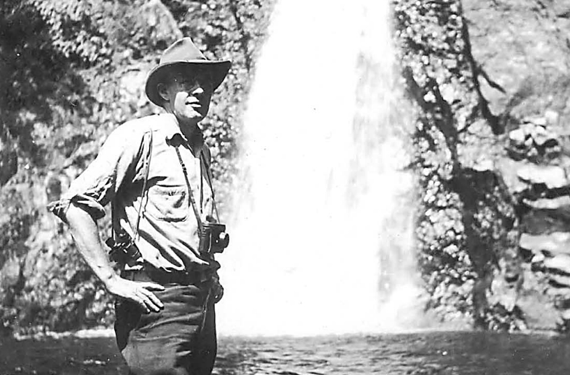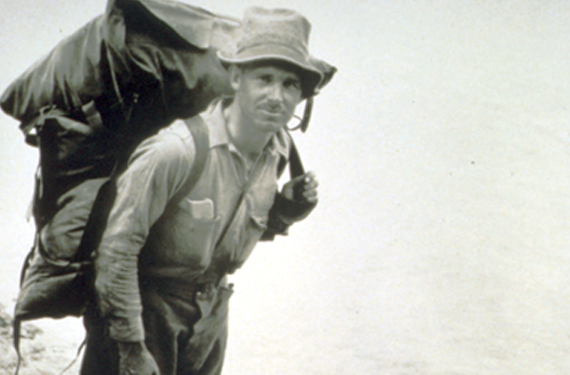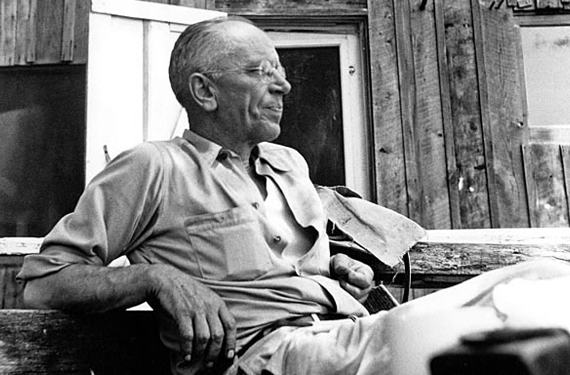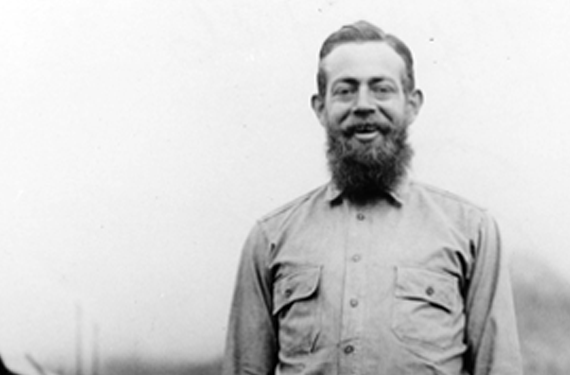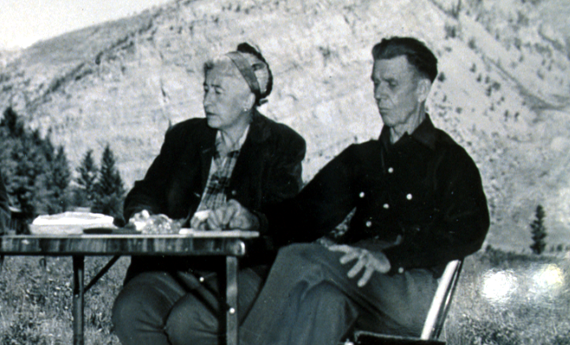People
Prominent Figures in Wilderness History
Important Wilderness Thinkers, Leaders, and Advocates
Edward Abbey (1927-1989)
Abbey 's writings, such as his books Desert Solitaire and The Monkey Wrench Gang, express his passion for wild undeveloped lands, especially in the desert southwest. Though not directly involved in the preservation of federal wilderness areas, Abbey raised public awareness about the power and significance of wildlands.
Ansel Adams (1902-1984)
Adams conveyed to the world his passion for wildlands through his photographs. He spent 37 years on the board of the Sierra Club, during which time he raised his voice loudly and often for wilderness preservation. "Wilderness is not only a condition of nature, but a state of mind and mood and heart," he said.
Clinton Anderson (1895-1975)
Former U.S. Senator, Congressional Representative and U.S. Secretary of Agriculture, Anderson influenced government environmental policy by sponsoring the Wilderness Act and other pieces of environmental legislation.
Wendell Berry (1934- )
Author of numerous books of essays, novels, and poetry, Berry often reflects upon the human relationship with place. His own place is his Kentucky farm, where Berry focuses time, energy and thought on sustainable living. Much of his writing delves into the human connection to wilderness.
Stewart Brandborg (1927-2018)
Raised in the mountains of Montana, Brandborg was on the front line with Howard Zahniser in the late 1950s and early 1960s working for passage of the Wilderness Act. From 1964 to 1976, he served as executive director of The Wilderness Society, which included the time of negotiations for the Alaska National Interest Lands Claim Act of 1980.
Harvey Broome (1902-1968)
One of the eight organizers of The Wilderness Society in 1935, Broome worked tirelessly on behalf of wilderness preservation. His eloquent wilderness writings were inspired by the Great Smoky Mountains, where he spent much of his life exploring.
David Brower (1912-2000)
As the first executive director of the Sierra Club from 1952 to 1969, Brower filled a leadership role for many conservation issues, including the opposition of a dam in Dinosaur National Monument in the early 1950s and the campaign for the Wilderness Act in the 1960s.
Arthur Carhart (1892-1978)
While no one person can be called "Father of the Wilderness Concept," Arthur Hawthorne Carhart has been referred to as "the chief cook in the kitchen during the critical first years." Throughout his life, he wrestled with issues that still resonate with environmentally aware Americans today, such as the tensions between modernism and anti-modernism and the problem of defining and delineating "wilderness." His contributions to the wilderness movement and his skill at uniting disparate groups, such as conservationists and hunters, toward a common goal are reflected in the organization that bears his namesake, the Arthur Carhart National Wilderness Training Center, which was founded in 1993 to foster interagency cooperation in wilderness stewardship.
Rachel Carson (1907-1964)
Carson was the first woman to take and pass the Civil Service Exam. During her time as a biologist and editor for the U.S. Bureau of Fisheries (which later became the Fish and Wildlife Service), Carson wrote several books about oceans and marine life. Success in her publications let her retire from government work to write full time. Because of the public and political reverberations from her book, Silent Spring, Carson has been credited with revolutionizing the modern environmental movement.
Frank Church (1924-1984)
Serving as a senator from Idaho from 1957 to 1981, Church was the wilderness bill 's sponsor in the Senate. In Congress, Church spoke to define the meaning and significance of wilderness, and through his words, the intent of the Wilderness Act was clarified. After passage of the Wilderness Act in 1964, Senator Church was involved in legislation designating wilderness areas across the United States, including the Eastern Wilderness Areas Act in 1975.
Ernie Dickerman (1910-1998)
Many have called Dickerman the "grandfather of eastern wilderness" because of his tireless efforts in local communities and in Washington, D.C., promoting the opportunity of designating wilderness areas in the Appalachians. At home in Tennessee near the Great Smoky Mountains, and later in life in the mountains of western Virginia, Dickerman was a charter member of The Wilderness Society in 1935, and later was instrumental in forming the Virginia Wilderness Committee.
William O. Douglas (1898-1980)
Douglas was an ardent conservationist during his time as an associate justice of the U.S. Supreme Court (1939-1975). In 1954, Douglas organized a 189-mile (304-km) hike along the Chesapeake and Ohio Canal towpath to protest a proposed highway in the canal right of way. The highway plans were abandoned. By spending time in Olympic National Park and the Arctic National Wildlife Refuge, Douglas also focused efforts to preserve these areas. During the time of the long legislative struggle to pass the Wilderness Act of 1964, Douglas published two books: My Wilderness—the Pacific West and My Wilderness—East to Katahdin.
Marjory Stoneman Douglas (1890-1998)
Referred to as "the mother of the Everglades ," Douglas wrote and spoke prolifically and passionately about the value of the wetlands in southern Florida. Her book, The Everglades: River of Grass, was instrumental in raising public awareness that led to the establishment of Everglades National Park in 1947. The designated wilderness area in Everglades National Park established in 1978 bears her name.
Pauline "Polly" Dyer (1920-2016)
Polly embodied the new breed of conservationist. ("Environmentalist" hadn't yet been coined.) She was at the vanguard of women in the movement. She left a sweeping 50-year legacy, including her unsurpassed contribution to the Wilderness Act of 1964. She'd used the word "untrammeled" to describe and successfully defend imperiled beaches in Olympic National Park against a 1958 road-building proposal. Howard Zahniser, who drafted the Wilderness Act, credited Dyer for the unique term.
Celia Hunter (1919-2001)
A champion for Alaska 's wildlands and wilderness values, Hunter focused much of her energy on advocacy for the Pacific Northwest. Hunter arrived in Alaska as a military pilot in the 1940s and decided to stay. There she initiated and maintained efforts for wilderness legislation, in particular the Alaska National Interest Lands Conservation Act (ANILCA). In the late 1970s, Hunter took on a national role as executive director of The Wilderness Society.
Aldo Leopold (1887-1948)
Aldo Leopold is acknowledged by some as the father of wildlife conservation. What may be a surprise to some is that he was one of the early leaders of the American wilderness movement. Throughout his life, he played many roles: wildlife manager, hunter, husband, father, naturalist, wilderness advocate, poet, scientist, philosopher, and visionary. Yet, he is best known as author of A Sand County Almanac, and Sketches Here and There. Beyond his descriptions of the natural world, in this writing Leopold articulated an innovative idea known as the "land ethic," a new way of thinking and acting toward the land. His namesake, the Aldo Leopold Wilderness Research Institute, is the only wilderness-focused research body in the country.
Georgina Mace (1953-2020)
A British zoologist, Georgina Mace redefined the International Union for Conservation of Nature's Red List, a global mechanism for determining which species are endangered and threatened. She developed the criteria to standardize assessments, making the Red List the most-used and trusted source for assessing trends in global biodiversity.
Benton MacKaye (1879-1975)
A passionate spokesperson against the uncontrolled urbanization of America, MacKaye envisioned a wilderness pathway in the eastern United States to which city-bound Americans could escape. Today, this vision is actualized as The Appalachian Trail. MacKaye 's idea of a network of wildlands contributed to the concept of a national wilderness preservation system. MacKaye was one of the eight founders of The Wilderness Society.
Bob Marshall (1901-1939)
Bob Marshall was a voracious outdoorsman. The sheer magnitude of miles he traversed, peaks he climbed, and little-known regions he explored constitute a great accomplishment. The passion he felt for these wildlands inspired him to found, with several other prominent conservationists, The Wilderness Society. His sudden death in 1939 at age 38 was a shock, yet Marshall 's extensive writings and vision continue to inspire the wilderness movement now inherited by those who share his passion and devotion.
George Perkins Marsh (1801-1882)
Throughout his 80 years, Marsh had many careers as a lawyer, newspaper editor, sheep farmer, mill owner, lecturer, politician, and diplomat. He also tried his hand at various businesses, but failed miserably in all - marble quarrying, railroad investment and woolen manufacturing. He invented tools and designed buildings including the Washington Monument. As a congressman in Washington (1843-1849) Marsh helped to found and guide the Smithsonian Institution. However, Marsh is best remembered today for his contribution of Man and Nature, a book in which he warned of the destructive impact of human activities on the environment. He is credited with being one of the first writers to raise concerns of this nature, and, although he may have missed the mark on some of his predictions, it is notable how relevant his volume is today. It sparked the Arbor Day movement, the establishment of forest reserves and the national forest system.
John Muir (1838-1914)
Muir is a legendary figure for wilderness advocates because of his undaunted and adventurous outdoor spirit. Even though Muir lived before organized efforts for a legislated national wilderness preservation system, his own advocacy for wildlands laid the groundwork for public support for future wilderness legislation. Many of his writings speak eloquently of the necessity of wilderness. Congress designated the John Muir Wilderness with the passage the Wilderness Act in 1964.
Olaus (1889-1963) and Mardy Murie (1902-2003)
Margaret (Mardy) Murie is fondly called the Grandmother of the Conservation Movement. She met Olaus Murie, a biologist, in Fairbanks, and they married in 1924 in a 3 a.m. sunrise ceremony in the village of Anvik on the Yukon River. Olaus and Mardy traveled extensively in Alaska, yet much of Mardy's conservation legacy, including her assistance in the passage of the Alaska National Interest Lands Conservation Act, takes place after Olaus' death.
Gaylord Nelson (1916-2005)
Best known as the father of Earth Day, the former Wisconsin Governor and U.S. Senator's environmental legacy continues to be celebrated every year on April 22. The Gaylord A. Nelson Wilderness, designated in 2004 in Wisconsin, carries his namesake.
Ernest Oberholtzer (1884-1977)
A defender of the northern Minnesota wildlands, Oberholtzer worked diligently to secure legislation that would protect wilderness areas. Ober - as he was called by friends - was one of the eight founders of The Wilderness Society. His visionary work and tireless advocacy led to the preservation of the Boundary Waters Canoe Area Wilderness and Voyageurs National Park in Minnesota, and Quetico Provincial Park in Ontario, Canada.
Sigurd Olson (1899-1982)
A prominent author and environmentalist, Olson helped protect the Boundary Waters Canoe Area Wilderness. He also helped establish Voyageurs National Park in northern Minnesota, Alaska's Arctic National Wildlife Refuge, and Point Reyes National Seashore in California, and was a consultant to Secretary of the Interior Steward Udall on wilderness and national park issues. The Sigurd Olson Environmental Institute, founded in 1972 as the outreach arm of Northland College in Ashland, Wisconsin, bears his name.
Gifford Pinchot (1865-1946)
Pinchot, America's first professionally trained forester, rose to national prominence as a conservationist and political progressive under the patronage of President Theodore Roosevelt. As a politician, he fought for wiser use of natural resources and for fuller justice for the average citizen. In 1897, Pinchot was appointed Chief of the Division of Forestry, a recognition of his advanced training in forestry and the need to protect American forests. In 1905, the Division was given control of the national forest reserves, and was renamed the Forest Service. It was Roosevelt and Pinchot who gave the name "conservation" to the movement for the preservation and wise use of all natural resources. They observed what they considered to be the reckless exploitation of these resources for private profit, and they predicted that unless scientific management of resources was required, America would fail to meet its future needs. Under Pinchot, the Forest Service added millions of acres to the national forests, controlled their use, and regulated their harvest.
Elizabeth Titus Putnam (1933- )
Founder of the Student Conservation Association, Putnam lived by three basic precepts: trust the land; take care of everything; and if you feel something needs to be done, do it. By establishing the Student Conservation Association, Putnam has provided opportunities for youth to learn about conservation, while completing much needed work in wilderness areas, for nearly 50 years. Since 1957, the Student Conservation Association has grown to become the oldest and largest provider of conservation services that trains the next generation of conservation leaders.
Wallace Stegner (1909-1993)
A novelist, teacher, and conservationist, Stegner wrote extensively about the environment. Focusing much of his writing on the environmental complexities of the American West, Stegner also actively campaigned in support of the Wilderness Act. His letter to a resource manager in the Kennedy administration, now referred to as the "Wilderness Letter," makes many clear statements about the need for preserved wilderness areas. In The Sound of Mountain Water (1969) he wrote, "We simply need that wild country available to us, even if we never do more than drive to its edge and look in. For it can be … a part of the geography of hope."
Henry David Thoreau (1817-1862)
Known for his many books, such as Walden and The Maine Woods, Thoreau promoted preserving natural areas from society 's industrialization and so-called development. His time was spent exploring and writing about New England . Originally stated in a speech on April 23, 1851, at the Concord Lyceum, a quote from his essay "Walking" is often misread and misinterpreted: "In wildness is the preservation of the World." In this passage, "wildness" is a concept and state of being aligned more with wilderness character than a designated place.
Stewart Lee Udall (1920-2010)
During Udall 's time as secretary of the Department of the Interior, several major conservation laws were passed, including the Wilderness Act, the Endangered Species Preservation Act, the Wild and Scenic Rivers Act, and the National Trails System Act. Udall was influential in the establishment of the Great Swamp National Wildlife Refuge, which includes the first Department of the Interior-designated wilderness area. In his work of environmental philosophy titled, The Quiet Crisis, Udall pressed for preservation of public lands for future generations and called for a rethinking of "land attitudes."
Robert Sterling Yard (1861-1945)
Yard is intimately associated with the beginnings of the National Park Service and the organization of the National Parks Association (now National Parks Conservation Association [NPCA]) in 1919. At the age of 76, Yard was one of the founders of The Wilderness Society. He served as The Wilderness Society 's first president until his death in 1945.
Howard Zahniser (1906-1964)
Zahniser is widely regarded as the father of the Wilderness Act for his role in drafting and shepherding the legislation through Congress. Through his childhood in northwestern Pennsylvania, he developed a life-long interest in nature and a love of literature. The eloquent language in the Wilderness Act includes the appropriately-descriptive word "untrammeled," suggested by Pauline "Polly" Dyer. Unfortunately, he died just months prior to the passage of the Wilderness Act.
